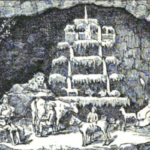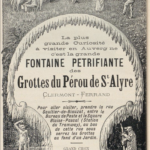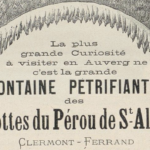In…Clermont is the fountain of St. Alyre, which petrifies whatever its water falls on, or rather covers it with a hard and gravelly incrustation. Grapes, chestnuts, cabbages, birds and birdcages, and even dogs and cows, have been thus encrusted over.
-from Knight’s Penny Magazine (1836)
Like the volcanoes by which it is encircled — all products of a millennia-long process of seismic alchemy — Clermont-Ferrand is an ancient, ever-changing city that has its fair share of secrets. Among its many hidden treasures are a series of thermal springs that formerly provided neighbourhoods with nutrient-rich bathing and drinking water. For centuries, one of these thermal sites — the fountain of St. Alyre — served as one of Clermont’s most popular tourist attractions.

In those long-past days, St. Alyre was advertised as a “petrifying fountain” — a miraculous spring that — like the ancient Greek figure Medusa — literally transformed anything into stone. In reality, the transformation was a kind of encrustation made possible by a series of naturally occurring minerals like lime, iron, and calcium carbonate. Over time, objects placed beneath the flowing stream of water accreted a whitish, stone-like crust. This meant that — to everyone’s delight — anything from toys to taxidermy could be turned into a custom sculpture.
In 1850, English writer Charles Richard Weld described the “petrification” process as follows:
“The water is collected in two large tanks, from which it drips into two chambers furnished with shelves. On these are placed various objects for incrustation. Stuffed monkeys, parrots, dogs, cats, and birds, were in different stages of transition; some nearly covered by the stony coat, others with their fur or hair delicately powdered, wearing a grisly appearance. The largest animal was a donkey, whose back and sides were coated. Fruits and the most delicate plants were undergoing the same process. The sediment deposited is so fine, that it is perfectly practicable to obtain the sharpest casts from moulds.”

Frequently mentioned in Old World tourist guides like Bradshaw’s, Murray’s, and Baedeker, the fountain at St-Alyre was a profitable family business for years. However, a reported drop in tourist numbers forced the attraction (which is situated on rue Gaultier de Biauzat) to close down in 2000. Unfortunately and despite the fact that St-Alyre’s living waters have not stopped, it remains closed to the public. Will it ever open its doors again? Only time will tell. Of course, there are reasons to be optimistic. Auvergne is a volcanic country; change is inescapable.
To receive more information on Hidden Clermont-Ferrand — sign up for our newsletter below!








